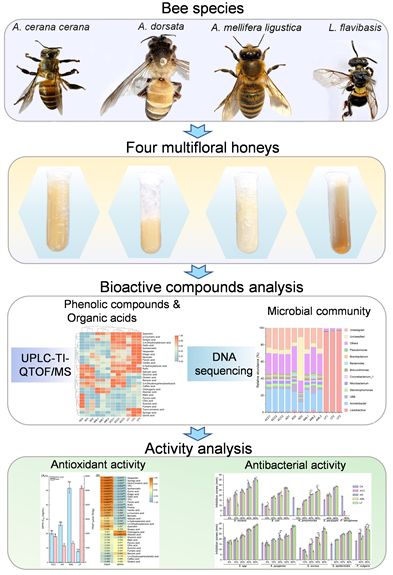The research team of bees and pollinators of the Environment and Plant Protection Research Institute of the Chinese Academy of Tropical Agricultural Sciences found that the main phenolic substances and contents of stingless bee honey in Hainan were significantly related to the antioxidant activity of honey, which provided an important theoretical basis for the development and utilization of tropical characteristic bee species.
Acanthus flavipectus is the main pollinator of flowering plants in tropical rain forest and tropical high-efficiency agriculture in Hainan. Geographical environment, honey source plants and bee species are the main factors affecting the quality of honey. Compared with traditional honey, stingless bee honey has sour taste and high medicinal value. At present, the active substances and functional evaluation of stingless bee honey in tropical areas are not clear. The research team took Hainan zhongbee, big bee and stingless bee and other characteristic bee species honey as research objects, and compared the differences in active compounds, antioxidant activities, microbial diversity and other aspects between different bee species and multi flowered honey in the same habitat. The results showed that the content of rutin, isorhamnetin, syringic acid, gallic acid, ellagic acid, hesperidin, ferulic acid, total phenols and total flavonoids in the honey of stingless wasp was 1 ~ 9 times higher than that of the honey of Zhongfeng and Dahua bee in Hainan. It can be used as an important characteristic substance to distinguish stingless wasp honey from traditional honey. Through the correlation analysis, it was found that these phenolic substances were significantly and positively correlated with the antioxidant activity of honey, which proved that the honey of the stingless bee with yellow stripes had stronger antioxidant capacity. Sequencing analysis of microbial diversity showed that the relative abundance of lactic acid bacteria in stingless bee honey was as high as 96.28%, which was significantly higher than that in Hainan zhongbee honey (0.67%) and big bee honey (1.28%), which was the main reason for its sour and sweet taste.

Comparison of active substances and activities of several characteristic honeys in Hainan
This research achievement was published in the TOP journal Food Research International under the title of "Bioactive character of multilateral phones from Apis cerana cerana, Apis dorata, and Lepidotrigona flavibasis". Dr. Wu Jiao of the Environment and Plant Protection Research Institute of CATAS is the first author of the paper, and researcher Gao Jinglin and associate researcher Wang Shijie are the co corresponding authors of the paper. The research was supported by the National Natural Science Foundation of China, the national modern agricultural industrial technology system (bee), the high-level talents of Hainan Province and other projects.


